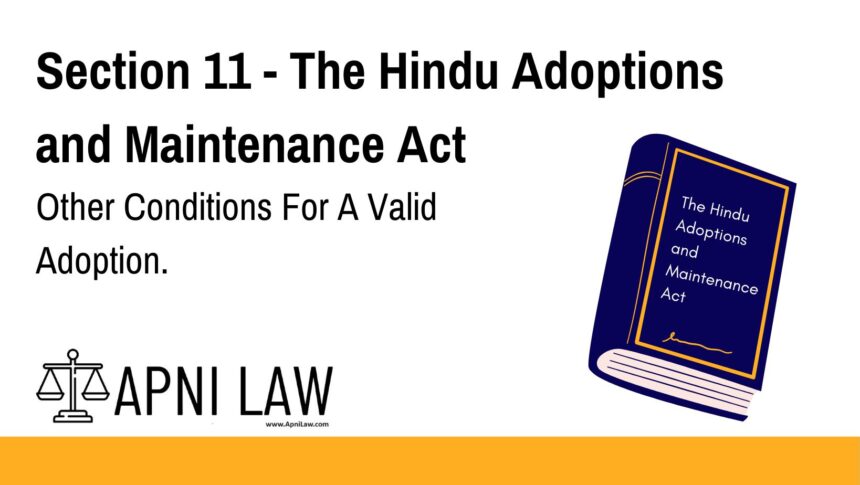Code: Section 11 – Other Conditions for a Valid Adoption
To ensure a valid adoption, the following conditions must be met:
- For adopting a son: The adoptive father or mother cannot have a living Hindu son, son’s son, or son’s son’s son at the time of adoption.
- For adopting a daughter: The adoptive father or mother cannot have a living Hindu daughter or son’s daughter.
- If the father is adopting a female child: The father must be at least 21 years older than the adopted daughter.
- If the mother is adopting a male child: The mother must be at least 21 years older than the adopted son.
- Simultaneous adoption is prohibited: One child cannot be adopted by two or more people.
- Actual giving and taking: The child must be physically given and taken in adoption, with intent to transfer from the birth family or current guardianship to the adoptive family.
Note: Performing datta homam is not required for the adoption to be valid.
Explanation of Section 11 – Conditions for a Valid Adoption
Section 11 lists specific conditions that ensure an adoption under The Hindu Adoptions and Maintenance Act is legally valid. These conditions focus on the rights and responsibilities of adoptive parents, ensuring the process is handled with integrity.
1. No Living Male Relatives for Adopting a Son
A man wishing to adopt a son must not have any male descendants (biological or adopted) living at the time of adoption. This rule preserves the legal and family structure.
2. No Living Female Relatives for Adopting a Daughter
A woman wishing to adopt a daughter must not have any living daughters (biological or adopted). This ensures that the family doesn’t already have an heir.
3. Age Requirement for Adopting a Female Child
If the adoptive father is adopting a female child, he must be at least 21 years older than the child. This age gap helps ensure the adoption is appropriate and the father can provide for the child’s welfare.
4. Age Requirement for Adopting a Male Child
If the adoptive mother is adopting a male child, she must also be at least 21 years older than the child. This condition promotes a mature and stable environment for the child’s upbringing.
5. Only One Adoption per Child
A child cannot be adopted by multiple people at the same time. This avoids confusion and ensures the child’s welfare is the primary concern.
6. Physical Transfer of the Child
The child must be physically handed over to the adoptive parents or guardians. This action solidifies the transfer of care from the birth family to the adoptive one.
7. Datta Homam Not Required
The datta homam ceremony, although a traditional Hindu custom, is not mandatory for an adoption to be legally recognized.
Illustration
Here are a few examples to illustrate Section 11’s conditions:
- Example 1: A man who already has a biological son cannot adopt another son unless he has no living male descendants at the time of adoption.
- Example 2: A woman wishing to adopt a daughter cannot do so if she already has a living biological or adopted daughter.
- Example 3: A 45-year-old man adopts a 15-year-old girl. Since he is more than 21 years older than her, the adoption is valid under Section 11.
Common Questions and Answers
1. Can a child be adopted by two or more people?
No, the law prohibits the simultaneous adoption of the same child by multiple individuals.
2. Is the datta homam essential for adoption?
No, performing the datta homam is not required for the adoption to be valid.
3. Can a man adopt a daughter if he already has a living daughter?
No, a father cannot adopt a daughter if he already has a living biological or adopted daughter.
Conclusion
Section 11 provides clear guidelines on the necessary conditions for a valid adoption. These rules ensure that the adoption process is fair and that the interests of the child, as well as the adoptive parents, are protected.








